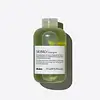What's inside
What's inside
 Key Ingredients
Key Ingredients

No key ingredients
 Benefits
Benefits

 Concerns
Concerns

 Ingredients Side-by-side
Ingredients Side-by-side

Water
Skin ConditioningSodium C14-16 Olefin Sulfonate
CleansingSodium Lauroyl Methyl Isethionate
CleansingCocamidopropyl Betaine
CleansingSodium PCA
HumectantDecyl Glucoside
CleansingDisodium Coco-Glucoside Citrate
EmulsifyingSodium Methyl 2-Sulfolaurate
CleansingLauramidopropylamine Oxide
CleansingCoco-Glucoside
CleansingGlyceryl Oleate
EmollientPanthenol
Skin ConditioningBenzyl Alcohol
PerfumingParfum
MaskingSodium Chloride
MaskingPolysorbate 20
EmulsifyingSodium Methyl Isethionate
EmulsifyingSodium Benzoate
MaskingCitric Acid
BufferingLauric Acid
CleansingDisodium 2-Sulfolaurate
CleansingMyristamidopropylamine Oxide
CleansingPolyquaternium-7
Trisodium Ethylenediamine Disuccinate
Guar Hydroxypropyltrimonium Chloride
Skin ConditioningTetrasodium Glutamate Diacetate
Sodium Laurate
CleansingCucumis Melo Fruit Extract
Skin ConditioningCI 19140
Cosmetic ColorantCI 61570
Cosmetic ColorantCI 14700
Cosmetic ColorantWater, Sodium C14-16 Olefin Sulfonate, Sodium Lauroyl Methyl Isethionate, Cocamidopropyl Betaine, Sodium PCA, Decyl Glucoside, Disodium Coco-Glucoside Citrate, Sodium Methyl 2-Sulfolaurate, Lauramidopropylamine Oxide, Coco-Glucoside, Glyceryl Oleate, Panthenol, Benzyl Alcohol, Parfum, Sodium Chloride, Polysorbate 20, Sodium Methyl Isethionate, Sodium Benzoate, Citric Acid, Lauric Acid, Disodium 2-Sulfolaurate, Myristamidopropylamine Oxide, Polyquaternium-7, Trisodium Ethylenediamine Disuccinate, Guar Hydroxypropyltrimonium Chloride, Tetrasodium Glutamate Diacetate, Sodium Laurate, Cucumis Melo Fruit Extract, CI 19140, CI 61570, CI 14700
Water
Skin ConditioningCetearyl Alcohol
EmollientCaprylic/Capric Triglyceride
MaskingPPG-3 Benzyl Ether Myristate
EmollientBehentrimonium Chloride
PreservativeBehentrimonium Methosulfate
C10-40 Isoalkyl Acid
EmollientC10-40 Isoalkylamidopropylethyldimonium Ethosulfate
Persea Gratissima Oil
Skin ConditioningPrunus Amygdalus Dulcis Oil
Skin ConditioningPlukenetia Volubilis Seed Oil
EmollientArgania Spinosa Kernel Oil
EmollientSchinziophyton Rautanenii Kernel Oil
EmollientVitis Vinifera Seed Oil
EmollientParfum
MaskingPhenoxyethanol
PreservativeDipropylene Glycol
HumectantButyrospermum Parkii Butter
Skin ConditioningPanthenol
Skin ConditioningOlea Europaea Fruit Oil
MaskingCocos Nucifera Oil
MaskingPhyllanthus Emblica Fruit Powder
Skin ConditioningTocopheryl Acetate
AntioxidantBenzoic Acid
MaskingEthylhexylglycerin
Skin ConditioningGlycereth-2 Cocoate
EmulsifyingDisodium EDTA
Citric Acid
BufferingWater, Cetearyl Alcohol, Caprylic/Capric Triglyceride, PPG-3 Benzyl Ether Myristate, Behentrimonium Chloride, Behentrimonium Methosulfate, C10-40 Isoalkyl Acid, C10-40 Isoalkylamidopropylethyldimonium Ethosulfate, Persea Gratissima Oil, Prunus Amygdalus Dulcis Oil, Plukenetia Volubilis Seed Oil, Argania Spinosa Kernel Oil, Schinziophyton Rautanenii Kernel Oil, Vitis Vinifera Seed Oil, Parfum, Phenoxyethanol, Dipropylene Glycol, Butyrospermum Parkii Butter, Panthenol, Olea Europaea Fruit Oil, Cocos Nucifera Oil, Phyllanthus Emblica Fruit Powder, Tocopheryl Acetate, Benzoic Acid, Ethylhexylglycerin, Glycereth-2 Cocoate, Disodium EDTA, Citric Acid
Ingredients Explained
These ingredients are found in both products.
Ingredients higher up in an ingredient list are typically present in a larger amount.
Citric Acid is an alpha hydroxy acid (AHA) naturally found in citrus fruits like oranges, lemons, and limes.
Like other AHAs, citric acid can exfoliate skin by breaking down the bonds that hold dead skin cells together. This helps reveal smoother and brighter skin underneath.
However, this exfoliating effect only happens at high concentrations (20%) which can be hard to find in cosmetic products.
Due to this, citric acid is usually included in small amounts as a pH adjuster. This helps keep products slightly more acidic and compatible with skin's natural pH.
In skincare formulas, citric acid can:
While it can provide some skin benefits, research shows lactic acid and glycolic acid are generally more effective and less irritating exfoliants.
Most citric acid used in skincare today is made by fermenting sugars (usually from molasses). This synthetic version is identical to the natural citrus form but easier to stabilize and use in formulations.
Read more about some other popular AHA's here:
Learn more about Citric AcidPanthenol is a common ingredient that helps hydrate and soothe the skin. It is found naturally in our skin and hair.
There are two forms of panthenol: D and L.
D-panthenol is also known as dexpanthenol. Most cosmetics use dexpanthenol or a mixture of D and L-panthenol.
Panthenol is famous due to its ability to go deeper into the skin's layers. Using this ingredient has numerous pros (and no cons):
Like hyaluronic acid, panthenol is a humectant. Humectants are able to bind and hold large amounts of water to keep skin hydrated.
This ingredient works well for wound healing. It works by increasing tissue in the wound and helps close open wounds.
Once oxidized, panthenol converts to pantothenic acid. Panthothenic acid is found in all living cells.
This ingredient is also referred to as pro-vitamin B5.
Learn more about PanthenolParfum is a catch-all term for an ingredient or more that is used to give a scent to products.
Also called "fragrance", this ingredient can be a blend of hundreds of chemicals or plant oils. This means every product with "fragrance" or "parfum" in the ingredients list is a different mixture.
For instance, Habanolide is a proprietary trade name for a specific aroma chemical. When used as a fragrance ingredient in cosmetics, most aroma chemicals fall under the broad labeling category of “FRAGRANCE” or “PARFUM” according to EU and US regulations.
The term 'parfum' or 'fragrance' is not regulated in many countries. In many cases, it is up to the brand to define this term.
For instance, many brands choose to label themselves as "fragrance-free" because they are not using synthetic fragrances. However, their products may still contain ingredients such as essential oils that are considered a fragrance by INCI standards.
One example is Calendula flower extract. Calendula is an essential oil that still imparts a scent or 'fragrance'.
Depending on the blend, the ingredients in the mixture can cause allergies and sensitivities on the skin. Some ingredients that are known EU allergens include linalool and citronellol.
Parfum can also be used to mask or cover an unpleasant scent.
The bottom line is: not all fragrances/parfum/ingredients are created equally. If you are worried about fragrances, we recommend taking a closer look at an ingredient. And of course, we always recommend speaking with a professional.
Learn more about ParfumWater. It's the most common cosmetic ingredient of all. You'll usually see it at the top of ingredient lists, meaning that it makes up the largest part of the product.
So why is it so popular? Water most often acts as a solvent - this means that it helps dissolve other ingredients into the formulation.
You'll also recognize water as that liquid we all need to stay alive. If you see this, drink a glass of water. Stay hydrated!
Learn more about Water